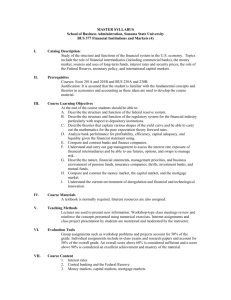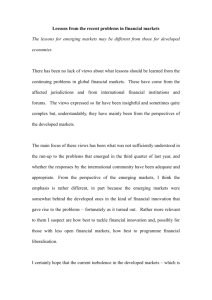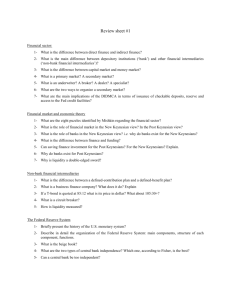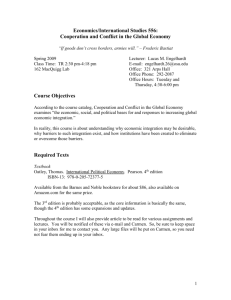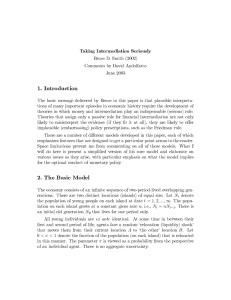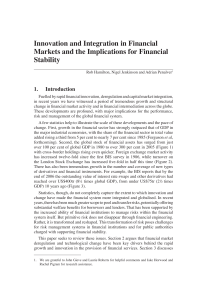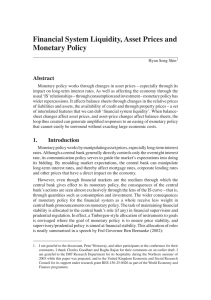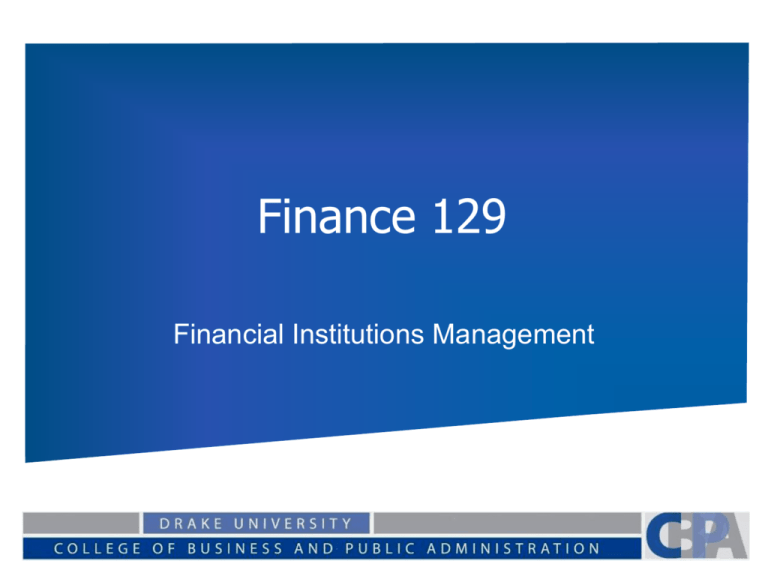
Finance 129
Financial Institutions Management
Syllabus
Textbooks
Financial Institutions Management
Prerequisites
Finance 101, Econ 105, Junior Standing
Rules of the Game
Office Hours /Contact Information
Website
Examinations
Academic Misconduct
Grades
Assignments
Disabilities
Evaluations
Academic Misconduct
Examples (include but not limited to:)
Copying from another student’s paper, laboratory
report or other report, or computer files and listings;
Using, during a test material and/or devices not
authorized by the person in charge of the test;
Without the instructors permission, collaborating with
another, knowingly assisting another or knowingly
receiving the assistance of another in writing an
examination or in satisfying any other course
requirement;
Misconduct Continued
Incorporating into written assignments materials written by
others without giving them credit, or otherwise improperly
using information written by others (including that which
may be stored on computer disks or other technological
devises), or buying and submitting commercially prepared
papers as one’s own work;
Submission of multiple copies of the same or similar papers
without prior approval of the instructors involved;
Claiming as one’s own work that which was done by tutors
or others with no mention of credit to or the assistance of
those persons.
Grades
Individual Assignments 200 points (20%)
Sept 15th
Oct 13th
Nov 3rd
Nov 22nd
50
50
50
50
points
points
points
points
Group Assignments (10%)
100 points
Tests (70%)
Sept 29th and Nov 10th 200 points each
Final 300 points December 13th
Course Description
Bank Vs. Financial Institutions Management
Years of deregulation
Financial Services Modernization Act 1999
(Gramm-Leach Bliley Act)
The “New” Financial Industry
Shadow Banking
Fall out from the credit crisis
The current economic environment
The Modern Bank
Services Provided:
Credit (loan) services
Thrift (savings) services
Payment (transaction) services
Investment and financial planning services
Investment Banking (security underwriting)
Brokerage (trading) services
Insurance Services
Other
Course Topics
Depository Institutions and the Financial System.
Introduction, financial intermediation
Intro to Management
UBPR, Dupont Analysis, Financial Analysis
Measuring Risk in FI’s
GAP analysis (Rate sensitive assets and liabilities)
Market, Liquidity, Credit, Operational and other Risks
Managing Risk
Liability and Liquidity Risk, Capital Adequacy
International Aspects
Foreign Exchange and Sovereign Risk
Background
Financial Institutions (FI) – Channel funds from
individuals and institutions with a surplus of
funds to (suppliers) to those with a shortage or
funds (users of capital).
Banks, Credit Unions
Insurance Companies
Mutual Funds
Pension Funds
*
*www.financialsectorfacts.org
Distribution of Assets
US Financial Sector
Accounts for over 7.6 million jobs
(approximately 5% of workforce)*
Activities in the industry account for
approximately 20% of GDP**
http://www.bls.gov/iag/tgs/iag50.htm ** average reported from 200-2007 by financialsectorfacts.org
Categories of FI’s
Depository Institutions
Banks, Savings and loans, Thrifts, Credit Unions
Nondepository Institutions
Insurance Co’s, Investment Banks, securities
firms, mutual funds and finance companies
Similar Risks and Rewards
All Financial Institutions:
Hold Assets that are subject to default (or credit)
risk
Are exposed to interest rate risk based on
maturity of assets and liabilities
Exposed to liquidity (withdraw) risks
Face operational costs and risks
Without FIs
Equity & Debt
Households
Corporations
(net savers)
(net borrowers))
Cash
©2003 McGraw-Hill Companies Inc. All rights reserved
Problems w/o FI’s
Monitoring is costly
Exposes households to increased risk
Lack of Liquidity
Households may not be able to easily convert
claims to cash
Price Risks
Prices fluctuate
With FIs as Intermediaries
FI
Households
Cash
(Brokers)
FI
Corporations
Equity & Debt
(Asset
Transformers)
Deposits/Insurance
Policies
Cash
©2003 McGraw-Hill Companies Inc. All rights reserved
Special Roles played by FI’s
Economy - Wide Services
Information, Liquidity, Price risk reduction,
Transaction cost and Maturity intermediation
services
Institution Specific Services
Monetary policy transmission (depository
Institutions), Credit allocation (thrifts, farm
banks), Intergenerational Transfers (Insurance
and pensions, payments services (depository
institutions) and Denomination intermediation
Roles played by FI’s
Brokerage Function
Research and information provider (reduces information
costs such as agency costs)
Economies of Scale (decreases transaction costs and
information costs)
Asset – Transformation Function
Purchase primary claims and issue secondary claims
(reducing contracting costs)
Allows for risk sharing via diversification (reduces price
and liquidity risk)
Other Functions
Maturity Intermediation
Provides households with desirable maturities
Intermediaries are willing to accept longer term
risks and finance them with short term deposits.
Denomination Intermediation
Commercial paper is issued in $250,000 units,
too large for most households
Payment Mechanism
Facilitate the payment of claims w/o cash.
Special Roles played by FI’s
Transmission of Monetary Policy
The liquid nature of depository institutions make
them the main way monetary policy is
transmitted to the public
Credit Allocation
Primary suppliers of capital to special sectors of
the economy (Residential lending for example)
Intergenerational Transfer of Wealth
Insurance and pension funds
The Impact of FI’s on
Economic Growth
Traditional Economic Theories of Growth
Labor Usage and Capital Accumulation
Limited by decreasing marginal returns to capital
-- sustained growth requires productivity growth
New Growth Theory
Technological change increases productivity that
offsets diminishing marginal returns
Financial Sector Development promotes
productivity growth
Termed “Endogenous Growth”
The Impact of FI’s on
Economic Growth
Financial Development’s Impact
Promotes Capital Accumulation & Productivity Growth
Rajan and Zingales (1998)
Young firms in higher productivity sectors depend upon external
financing and benefit from low cost financing associated with
financial development
Galindo, Schiantarelli, and Weiss (2002)
Financial liberalization in developing economies improves capital
allocation
Both Studies stress the importance of the quality of
regulation, supervision and enforcement.
Regulation
Given their vital role in the economy FI’s are
highly regulated. The goal of this regulation is
to protect against a disruption in the services
they offer (provide confidence in the system).
Some segments of the population could be
discriminated against without regulation (race,
gender etc)
The difference the private benefits and private
costs of regulation are the net regulatory
burden.
Safety and Soundness Regulation
Protects borrowers and depositors against
failure of the FI
Diversification requirements
Minimum capital to asset ratios
Guaranty funds provisions
Monitoring and surveillance
Monetary Policy Regulation
Since Financial Intermediaries serve as a
conduit for monetary policy they merit special
regulation.
Reserve requirements, for example.
Might make control of monetary policy more
predictable.
Credit Allocation Regulation
Supports lending to portions of the economy
deemed socially important (housing and
farming are two examples).
Requiring a % of assets in a particular sector of
the economy for example. Also interest rate
restrictions.
Consumer Protection Regulation
Home Mortgage Disclosure Act
Prevents discrimination in lending based upon
gender, race, age, or income. Requires
standardized form on why credit is granted or
denied
May provide a heavy net regulatory burden
without an offsetting social benefit.
Investor Protection Regulation
Protection of investors that use investment
banks directly. Insider trading restrictions, lack
of disclosure and breach of fiduciary
responsibility are examples.
Entry Regulation
Barriers to entry can promote safety and
soundness.
Also impose costs on current market
participants.

